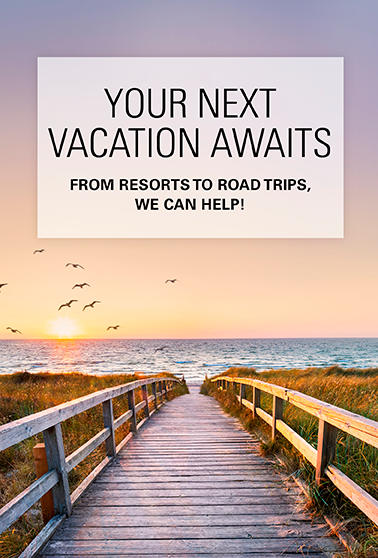See Iceland’s natural beauty on the Ring Road and beyond
Dreaming of your future adventure? Find out what Icelandic wonders you can see with our recommendations for activities beyond the capital, Reykjavík, including worthy stops on and off the Ring Road.

Driving routes to see Icelandic wonders
While Iceland’s capital is a wonderful destination in its own right, one of the best things about visiting Reykjavík is getting out of the city to explore the natural marvels in the surrounding countryside. The most ambitious choice is Route 1, aka the “Ring Road,” which covers 828 miles of jaw-dropping waterfalls, glaciers, canyons and beaches on its loop around the country. It takes seven to 10 days to drive the entire route and have an undoubtedly memorable adventure, but you still can get a taste of Iceland’s scenic wonders on a side trip from the capital for a day or more. Here’s a look at Iceland’s most enticing natural settings.
Skógafoss and Seljaladsfoss
You’ll quickly learn on your Ring Road journey that “foss” is Icelandic for waterfall, and two of the country’s most visually stunning are just under two hours from Reykjavík. At Skógafoss, which thunders 200 feet, frigid water from the Skógar River forms a misty curtain over 80 feet wide, which made an appearance in the movie Thor: The Dark World and is often capped with a rainbow. Culture buffs can tour the turf houses at folksy Skógar Museum, or visit Kvernufoss, a second waterfall, that’s hidden in a nearby ravine. The view of Seljaladsfoss is particularly dramatic late in the day, because you can watch the sunset from a trail that leads directly behind the falls.

Vík
If black-sand beaches are high on your list, head to Vík on the island’s southern coast. Just two and half hours from Reykjavík by car, Vík is close to Reynisfjara Beach where jet-black sands meet basaltic columns that teem with puffins each summer. The entire scene is backed by the white of Mýrdalsjökull glacier, and if time isn’t an issue — or you’re staying overnight — consider visiting the beach at sunset to see why this place is consistently named one of the world’s best beaches.

Golden Circle
Even though it isn’t part of Route 1, the “Golden Circle” is such a popular day trip — expect some crowds — that it may as well be an official extension of the Ring Road. This 155-mile loop passes so many scenic, natural attractions that it’s kind of like driving around the country in a single day. You can stand at the base of Strokkur geyser and try your best to not flinch when water jets as high as 66 feet in the air, and visit thundering Gullfoss waterfall, where glacial water from the Hvítá River spills 100 feet through a canyon. Or, if you’re feeling extra brave (and make advance arrangements), you can stop at Thingvellir National Park to slip on a dry suit, snorkel and mask and go swimming between tectonic plates in the icy-clear Silfra fissure.
Remote Ring Road Treasures
Jökulsárlón Glacier Lagoon
This iceberg-laden lagoon, about four and a half hours away from the capital, is the spot where you can boat between icebergs, and then take a stroll down a black-sand beach that sometimes gets covered in chunks of ice. Both are located just steps from the road, which makes it one of the few places where (mostly green) Iceland lives up to its name.
Lake Mývatn and Námaskarð
Check out this volcanic lake, Lake Mývatn, before heading to the Mývatn Nature Baths that are near Námaskarð. These are naturally heated thermal lagoons, like the famous Blue Lagoon just outside Reykjavík. But the otherworldly, volcanic surroundings could end up throwing a wrench in your plans by making you want to extend your stay. At Námaskarð, just off the Ring Road, you can walk amidst steaming thermal vents and past bubbling pools of mud, or make a short drive up Krafla volcano to see the spectacular, aquamarine water inside of Víti Crater. Remember to check the road conditions in winter. If you need to stretch your legs for a bit — this is six hours from Reykjavík, after all — wander the trails at Dimmuborgir, where rock formations rise up like fortresses.

Goðafoss
Considering Iceland has many waterfalls, you’re forgiven if you end up skipping a few, but you won’t want to miss Goðafoss, which is less known for its horseshoe-shaped plunge than its unique role in Iceland’s history. When the lawspeaker Þorgeir Ljósvetningagoði made the decision in 1000 A.D. that Iceland would forsake Norse gods in favor of Christianity, it is said that he stood on the edge of Goðafoss and cast the idols of the gods into the waters. The name Goðafoss translates to “God Falls.” DJÚPIVOGUR By the time you make it out to the East fjords, you are about seven hours away from Iceland’s capital and on the opposite side of the “ring.” Djúpivogur, like its neighboring fjord towns, has a population of around 500 people and is heavily reliant on fishing. Unlike its neighboring fjord towns, however, Djúpivogur has something they don’t — historic Hótel Framtíð — which was transported in pieces from Copenhagen by a merchant in 1905 and 1906. It since has been renovated into an impeccably charming and modern accommodation, and if the restaurant is serving seafood chowder, don’t hesitate; just get it.

Off the Ring Road
Tröllaskági
If your itinerary allows for a two-day getaway from the capital, make a trip up the rugged Tröllaskagi peninsula on the island’s northern coast. Fishing villages hide behind peaks that seem to rise 4,000 feet from the sea, and the rugged terrain has helped the area retain a serene and romantic degree of simple isolation. Begin the trip in Akureyri — “capital of the north” — and head toward Dalvík for a morning of whale watching before ending the day in Siglufjörður and the Herring Era Museum. In the 1950s this port town smelled of two things: herring and cash, but the fishing industry eventually collapsed, and only recently has tourism helped to fill the economic void. After spending the night at Sigló Hotel in a room overlooking the water, drive southwest to Hofsós to swim in a pool that’s not only heated by geothermal energy, but sits on a high, coastal bluff, making it feel like an infinity pool with an expansive ocean view.

Snaefellsnes Peninsula
When Jules Verne wrote Journey to the Center of the Earth, he chose west Iceland’s Snæfellsjökull volcano as the spot where lava tubes lead to a secretive, subterranean world. Though you probably shouldn’t follow their route (considering it’s inside a volcano), you can still explore the beaches, waterfalls, glacier and trails that surround the volcano today. Although it is possible to visit the peninsula in one day, you truly can experience the area’s treasures by staying overnight. For a literal taste of Icelandic culture, try hákarl — fermented Greenland shark — at the Bjarnarhöfn Shark Museum, though be forewarned that Anthony Bourdain called it the “single worst thing I’ve ever put in my mouth,” and “unspeakably nasty.” Walk the golden Ytri Tunga sands to watch harbor seals splash in the waves, or watch the sun set behind Kirkjufell mountain just west of Grundafjörður village.

8 Tips for Driving in Iceland
- Cars travel on the right side of the road.
- You don’t need 4-wheel drive in summer as long as you stay on the Ring Road, but it’s good to have between October and April.
- If a road name starts with an F, it’s for 4-wheel drive only.
- Weather and road conditions change quickly in Iceland; check www.road.is for the latest closures and weather.
- The speed limit generally is 90 kph (56 mph) on paved rural roads, and 50 kph (31 mph) in urban areas. There are speed cameras around Reykjavík.
- Some car rental agencies have offices in Reykjavík, so you can catch the Flybus from Keflavík airport, which is about 45 minutes from Reykjavík, and spend a few days without a car if you don’t feel like you’ll need one in the city.
- Vehicle navigation systems and GPS have reliable signals in settlements and on the Ring Road, generally.
- Beware of sandstorms on the southern coast. There’s even insurance to protect against them.
– Written by Kyle Ellison
This story originally appeared as “Icelandic Wonders” in the March/April 2019 edition of Journey magazine.

Travel Planning Tips
Get expert advice: Your perfect getaway awaits. No matter what destination you choose, or how you wish to travel, AAA Travel experts can help you plan a perfect experience that you will remember for years to come.
Purchase travel insurance: Protect your trip investment with travel insurance.
Consider Concierge: AAA’s Concierge Vacations feature done-for-you details and special amenities for travel to world-wide destinations. AAA Travel Agents will make your planning a breeze and your vacation unforgettable.
On the road: Get ready for every trip with a AAA Membership. Get peace-of-mind on the road and much more.
Save with discounts: AAA membership gives you access to exclusive discounts nationwide.









